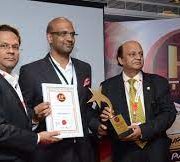Telecom minister, Manoj Sinha announced to the world at the Mobile World Congress in Barcelona, Spain that India would not miss the 5G bus. A high power committee has been setup under the leadership of the Telecom Secretary. Airtel announced a 5G trial recently. A slew of test beds are coming up all over the country in the premier academic institutes of the country and in the labs of the operators.
These laudable initiatives need the following key focus areas to accelerate the deployment of 5G in the country.
- Identification of verticals and segments that can benefit from 5G along with the necessary value added services
- Friendly spectrum pricing and policies
- Communications backbone
- Expertise and vendor ecosystem
5G supports multiple verticals under three main categories – enhanced Mobile Broadband (eMBB), massive Machine Type Communications (mMTC) and Ultra Reliable Low Latency Communications (URLLC) for mission critical applications. 5G only provides the transport pipe that is required by these verticals. Applications that support value added services need to be developed.
The entire railway infrastructure in the country may be revolutionized utilizing the mMTC and URLLC capabilities of 5G. The complete operation and maintenance of the railways may be automated, centralized, and optimized leading to reduced prices, increased safety, and increased quality of service to customers. For example, the monitoring of critical components of the coaches and their proactive maintenance may be fully automated using sensors. The complete process from monitoring, reporting maintenance needs, seeking such maintenance, scheduling it, and reporting completion of maintenance may be automated. This would lead to better maintenance of the coaches, longer life along with increased safety and reduced prices due to more efficient operations. However, this needs applications, big data, analytics, and massive IT infrastructure to also be deployed on top of the 5G communications service.
Smart Cities and Smart Energy are other initiatives that may be facilitated by the support for the Internet of Things (IoT) in 5G. Smart parking, smart traffic management, and smart transport can significantly ease the congestion in the cities. Smart lighting and smart meters can go a long way towards conserving critical natural resources and reducing the carbon footprint. A stimulus to these segments will go a long way in creating a massive demand for 5G in the country while at the same time making the cities greener and better places to live in.
Augmented/Virtual Reality applications may be stimulated to finally realize the dream of the virtual office that was promised during the networking revolution but never materialized. This will go a long way to ease the congestion and pollution that dogs our urban centers.
The same applications may be used to give the rural population access to the all the expertise and technology that is available in the urban centers hence increasing the inclusion of the rural population in the main stream. With the transformation of the country to “digital” and a number of procedures going “online” it is imperative that the entire population has mobile broadband access. While the rural penetration has improved in recent years the coverage and capacity are still far from sufficient. IoT has a role to play in rural areas also with applications such as smart water supply, automated smart irrigation, automated soil testing and reporting, etc. 5G can offer this additional coverage and capacity to the rural areas in an economically viable fashion.
All of these are far reaching use cases beyond the consumer broadband space where the use of social media and rich multimedia content generation and consumption is always on the increase. In the consumer broadband space the demand for data continues to increase with more and more entertainment content being available on mobile and with more and more multimedia rich social networking platforms becoming popular.
Once the demand has been stimulated the supply chain could be stimulated next. The supply of 5G services will come from the cellular wireless service providers and the biggest stimulus they are clamoring for today is friendlier spectrum pricing and policies. India has historically had one of the highest spectrum costs globally and this needs to be changed to encourage early adoption of 5G. The 3.3-3.4 GHz and 3.4-3.6 GHz bands have been identified already for auctions. However, for the full power of 5G to be unleashed at least 100 MHz of bandwidth will be required. With some private networks, satellite services, and navigation services already occupying the identified band there may not be sufficient space to allocate a contiguous 100 MHz to more than one bidder even if the price is made attractive. So bandwidths beyond 3.6 GHz should also be considered as the 3.3 – 4.2 GHz band is being globally harmonized for 5G today. Finally, it is the right time to start considering mmWave policy in time for the next ITU-R WRC in 2019 following which a mmWave policy may be formulated for the country.
One of the key aspects of 5G is that it allows the network to be virtualized. This automatically means that it is better suited for sharing. Therefore, policies have to be formulated which facilitate and maybe to some extent mandate that the cellular wireless service providers share infrastructure effectively to reduce the cost of offering the services.
To fully reap the benefits of 5G while it is seen primarily as a cellular wireless technology there are radical transformations required in the backbone networks. Therefore backbone network infrastructure in the country will need to be upgraded to support the capabilities of 5G technology. 5G offers optimization of cost by utilizing virtualization and cloud architectures. Migration of back bone network infrastructure from a fixed physical configuration to a virtualized software defined environment has to be planned in parallel to the deployment of 5G. Cell tower location and connection to the backbone network will continue to be a huge challenge in both urban and rural centers. The fiber infrastructure in the country will have to be upgraded while at the same time point-to-point, line-of-sight and non-line-of-sight wireless links all have to be exploited. In short access, backhaul and the core backbone networks all have to upgrade to 5G and not the radio technology alone.
Finally, the solutions and expertise required for deploying, operating and maintaining 5G networks and applications has to be available locally. Stimulus and policies are urgently needed to address both solutions and expertise development in the country. The Make in India is a good initiative but it needs to be extended to conceptualize, design, and make for India! This will create both the solutions and expertise pool locally that is required to accelerate the successful deployment in India. There needs to be a common vision shared between Academia, Industry and Government towards building expertise and towards conceptualizing, designing and developing solutions that meet the needs of the country.
In conclusion, the intention to accelerate 5G adoption in India is laudable. The possibilities are infinite and with the right focus this may be one of the technology bedrocks on which India enters the next generation as a technology driven super power!
About the Author
Balaji Rangaswamy is the CEO/CTO of Sooktha. He was formerly managing the Cellular Access Network Services Portfolio in Sasken Technologies and most recently Head of Technology and Architecture in Nokia, Bangalore. He has extensive expertise and experience in 3GPP specifications and translating them to related products in the Network Infrastructure, CPE and Test segments.
Sooktha is an advanced wireless access company developing base stations and test solutions in cellular access for LTE, NB-IoT and 5G. The LTE and NB-IoT portfolio include a range of base station products and a box-EPC that can be used for testing and in adhoc/private networks. Sooktha has an aggressive roadmap for 5G implementation and will offer both 5G small cell base stations and a complete 5Gtest bed by the end of they year.







